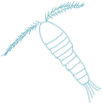
Infinitely small or Plankton & hydrocarbons

Information
- Year : 2015
- Dimensions : 39.3701 x 46.4567 inches
The artistic process
Here is water seen under the microscope: phyto and zooplankton, with a chemical molecule in blue (benzene cycle) symbolizing water pollution by hydrocarbons. The importance of plankton, the basis of marine ecosystems, is underestimated: its biomass (98% of marine biodiversity) serves as a buffer for bioclimatic balances. A quarter of the 40 billion tons of CO2 emitted by human activities each year are absorbed by the living ocean*. During a mission to impact study for TOTAL in Borneo (Mahakam Delta), Nicole King discovered a species of copepod (zooplankton crustacean), consequently named after her “Acartiella nicolae**”.
* Conférence Hôtel de Roquelaure, Paris 7, “Ocean, future of humanity?” with G. Bœuf, 4/6/2019
** Crustaceana by prof. Bernard Dussart, specialist in copepods (1986)








